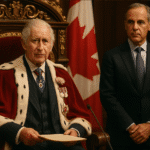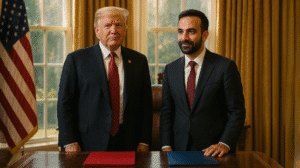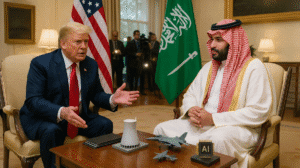In the volatile landscape of the Israeli-Palestinian conflict, it is often said that peace is elusive. But increasingly, it seems peace is not just elusive—it is structurally impossible under current leadership. A closer examination of the ideologies of Israel’s Likud Party and Palestinian group Hamas reveals that, despite appearing to be polar opposites, their political platforms share a strikingly similar flaw: an absolute claim over the land “from the river to the sea” and a vision rooted in exclusion rather than coexistence.
Between these two hard-line camps sits Fatah, a secular Palestinian nationalist party that has historically been sidelined in recent years. Once the dominant force behind the peace process, Fatah now finds itself weakened by internal dysfunction, external pressure, and a lack of public trust. Yet, paradoxically, it may be the only one of the three with the ideological space and legitimacy to support a peaceful resolution—if only it could regain strength or evolve into something new.
Likud and Hamas: A Mirror Image?
The Likud Party, founded in 1973 by Menachem Begin and others, has long been associated with right-wing Zionism and Jewish nationalist aspirations. Its 1977 platform famously declared: “Between the Sea and the Jordan there will only be Israeli sovereignty.” Though softened in public discourse in later years, this foundational view remains consistent in its rejection of Palestinian statehood, particularly under the leadership of Benjamin Netanyahu. The 2018 Nation-State Law, passed under a Likud-led government, further codified Jewish supremacy by stating that only Jews have the right to national self-determination in Israel.
On the other end of the spectrum is Hamas, an Islamist organisation that governs the Gaza Strip. Founded in 1987 during the First Intifada, Hamas’s 1988 Charter is unambiguous in its call for the destruction of Israel. It states: “Israel will rise and remain until Islam eliminates it.” The land, it argues, is an Islamic Waqf (religious trust), consecrated to future Muslim generations.
Despite their religious and political differences—one grounded in Jewish nationalism, the other in Islamic theocracy—both parties articulate a maximalist territorial claim and reject the legitimacy of the other’s national aspirations. Neither supports a viable two-state solution, and both have shown through policy and action that power is valued more than compromise.
In effect, Likud and Hamas are two sides of the same ideological coin: unwilling to recognise the other, driven by theology or historical entitlement, and sustained by fear and absolutism.
Fatah: Flawed but Fundamentally Different
Founded in 1959 by Yasser Arafat and others, Fatah predates both Likud and Hamas. Its political charter, dating back to the early 1960s, was rooted in secular Palestinian nationalism. While its early years supported armed struggle, Fatah evolved, notably after the Oslo Accords, into a movement that embraced negotiation, diplomacy, and a two-state vision. Unlike Hamas, it recognised Israel’s right to exist. Unlike Likud, it envisioned a Palestinian state alongside Israel, not in place of it.
Today, Fatah governs the Palestinian Authority in parts of the West Bank and maintains diplomatic ties with dozens of countries. It remains more open to compromise, and while its record on governance is far from perfect—dogged by corruption, factionalism, and a stagnant leadership under Mahmoud Abbas—it represents a pluralistic and civil framework that neither Likud nor Hamas can match.
The irony is that Fatah, long dismissed by more radical elements as “too weak,” may be the only actor among the three with a political philosophy compatible with coexistence.
Why Fatah Can’t Deliver—Yet
Despite this ideological advantage, Fatah cannot currently take the lead toward peace for several reasons:
Loss of Public Support: Many Palestinians see Fatah as ineffective and out of touch, especially as the younger generation turns to Hamas for resistance or to independent movements for reform.
Division with Hamas: The Palestinian territories are politically split, with Hamas ruling Gaza and Fatah governing parts of the West Bank. Their internal rivalry undermines any unified strategy.
Israeli Containment: Under successive Likud-led governments, Fatah’s influence has been systematically eroded. Settlement expansion, military incursions, and the delegitimisation of the Palestinian Authority have left it politically paralysed.
International Fatigue: The international community has grown weary of the peace process, offering little incentive or support for Palestinian political renewal.
This creates a tragic paradox: Fatah is the most ideologically equipped for peace but the least politically empowered to achieve it.
A Third Path: The Case for a New Technocratic Party
Given the hard-line positions of both Likud and Hamas, and the diminishing returns of Fatah, the time may be ripe for a new political force—one that is not weighed down by the blood and rhetoric of past conflicts. A technocratic movement, rooted in pragmatism, diplomacy, and international norms, could provide the fresh vision needed to engage both sides.
Such a party would not be built around ethnic or religious ideology, but rather around shared governance, development, and security. It would aim to:
– Represent the majority of Israelis and Palestinians who desire peace but feel politically orphaned;
– Engage international partners with credibility and neutrality;
– Serve as a diplomatic bridge between the ideological extremes;
– Restore the civic and economic space necessary for coexistence.
This model is not without precedent.
Lessons from Tunisia and Lebanon
In Tunisia, following the fall of the Ben Ali regime in 2011, the country faced deep political polarisation between Islamists (Ennahda) and secularists. Fearing civil unrest, a technocratic caretaker government led by Mehdi Jomaa was appointed in 2014. Though limited in duration, his government helped stabilise the country, draft a new constitution, and organise elections without descending into chaos. Jomaa, a former engineer and industry minister, brought neutrality and credibility to the post—a sharp contrast to ideological actors.
While Tunisia’s democratic transition has since faced setbacks, the Jomaa period showed that technocrats can bridge national divides when traditional parties are too toxic to govern.
In Lebanon, the 2019–2020 protests called for a similar solution. Citizens demanded a government of independent experts to end decades of sectarian corruption and economic mismanagement. In response, Hassan Diab, a former professor and technocrat, was named prime minister in early 2020. His government, while short-lived and constrained by entrenched interests, demonstrated the popular appeal of non-partisan leadership in fragile states.
Though Diab’s tenure ended amid the Beirut port explosion and mounting pressure, his appointment showed that technocratic leadership can command public trust, especially in moments of crisis—even if it lacks the tools to overcome deep systemic failures without full support.
In both Tunisia and Lebanon, technocrats stepped in not to replace politics permanently, but to reset the political system. The Middle East has no shortage of professional talent—engineers, economists, diplomats—but they have often been pushed aside by militarists, clerics, and demagogues.
Toward a Diplomatic Renaissance
The failure of Likud and Hamas to move beyond historical grievances and religious exclusivity has entrenched the conflict further than ever. The cost is measured in lives, homes, and the moral erosion of both societies.
Fatah’s platform, flawed but inherently more inclusive, provides a roadmap for a better future—but not without renewal. It needs new leadership, fresh alliances, and perhaps a new vehicle entirely to carry forward the vision it once championed.
The answer may lie in a hybrid model: a technocratic movement with roots in both Israeli and Palestinian civil societies, backed by international partners and committed to laying the foundation for future elections, joint economic zones, and shared governance frameworks.
The Middle East has seen how technocracy can steady the ship during chaos. Now, it needs to build one for peace.















